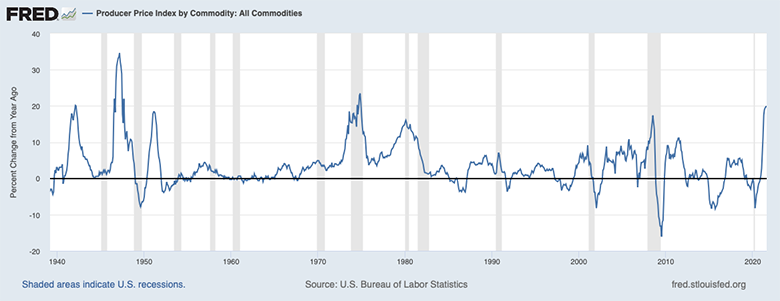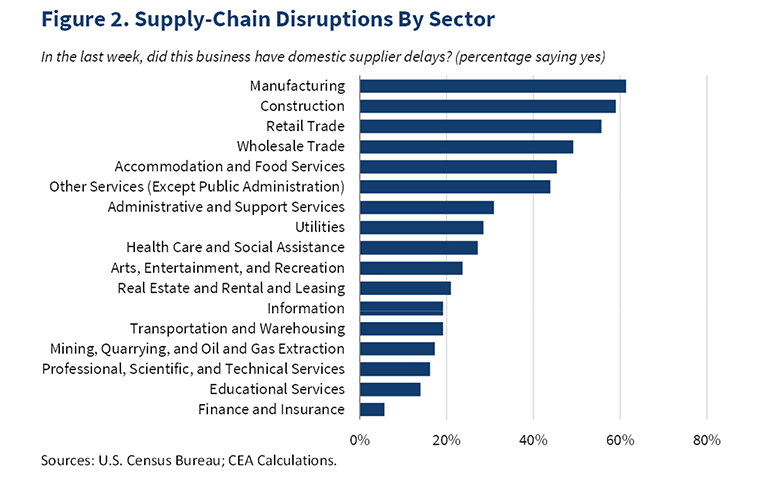
ARTICLE
How to Adapt as Global Supply Chain Disruptions Continue
By Bill Geary | January 3, 2022
Read Time: 8 Minutes
Much of the world continues to experience supply chain strain, with challenges coming in a variety of forms. Transportation and freight disruptions, increased prices on metals and other materials, shortages of plastic resin and semiconductor chips – these are just a few of the aspects involved. Those industries with complex supply chains that rely on inputs from other businesses that also experience shortages and delivery challenges are especially hard hit.
What the New York Times has called “The Great Supply Chain Disruption” has had its effect across the globe. When consumer demand for a product in Asia that needs a computer chip increases, production of another product in North America that needs the same chip decreases. And the problems don’t end with a simple equation of supply and demand.
Price increases are another direct effect. According to the Producer Price Index, we have recently seen the largest year-over-year increase since 1974.
 Figure 1
Figure 1
This is not a simple “us” or “them” problem. Manufacturers, suppliers, distributors and end-users are feeling the effects and working to overcome multiple challenges.
So, why do we continue to see cracks across global supply chains?
One simple answer is that these issues have exposed frailties that have always been there – all it took was a push to bring them to the surface. Vulnerability, dependence and inflexibility are all terms heard consistently when discussing factors that work toward disruptions in a supply chain.
What’s becoming increasingly clear is that few will be completely unaffected by supply chain disruptions. But there are steps you can take right now that can help in the near term and carry your business forward, well into the future.
 Figure 2
Figure 2
Here we’ll explore four key areas affecting the global supply chain and offer some ways to help ensure a more reliable and resilient supply chain for your business.
What to Expect
Transportation and Freight: From ports in China to truck drivers in Europe and Mexico
Domestic and international freight has had to overcome considerable hurdles over the last year. Port terminals in China are undergoing what is described as “system disruptions” that suspend outgoing traffic, having a significant impact on delivery time and cost. Meanwhile, on the other side of the world, the number of container ships waiting to port is rising as well. This is creating an imperfect storm of events to drive spot rates for 40-foot containers to record highs.
Logistical challenges to deliver goods to port and a years-long driver shortage are causing strain in supply chains across Europe. The same driver shortage is taking place in Mexico, with an aging workforce and low retention rates cited as the primary factors there. One survey from The International Road Transport Union reports that Mexico’s driver shortage could increase by 18% by the end of the year.
Every country has to contend with its own domestic issues. In the United States, for example, there is a higher emphasis on the significant parcel and last-mile delivery contracts. Additionally, the port and hub congestion delays we touched on earlier are also impacting domestic freight delivery.
The good news on the horizon is that a higher container capacity will help to reduce freight costs, but we won’t experience an ease in pricing until 2023.

Metals: It's not just copper
Steel prices are continuing their upward trajectory in 2021 as demand grows faster than what is available. Scrapmonster reported that hot-rolled steel hit a record high of $96 per CWT. Similarly, copper is up 88% since the beginning of 2021 and aluminum prices are at a three-year high as of the end of June, according to Business Insider and Tradeservice. Peru, one of the world’s largest producers of copper, took a big hit early on as mines shut down for months, with President Martín Vizcarra declaring it “the most serious crisis in our history.”
There are numerous other factors to consider as reasons behind these shortages – tariffs on steel and aluminum, higher freight costs, energy sustainability and electric vehicle growth have all played a part in rising metals prices.

Resins: A cornerstone component
Just as resin production started to recover from the Q1’21 storms in Texas and Louisiana that impacted 80-85% of domestic resin output, Hurricane Ida hit the coast. We will continue to see additional disruptions and declarations of force majeure. A majority of pricing contracts are now weekly, not monthly, and depleted safety stocks are compounding the shortage. In the EU, some 90% of plastics converters are affected by supply chain strain, so much so that some need to not only reduce production but deny product to any new customers.
Taken as a whole, these events have placed significant pressure on plastic resin suppliers, despite rising needs in all relevant sectors.

Chips: Affecting more than just computers
Semiconductor chips are in virtually every electric-powered device, appliance and car in production, and global supply chain issues have not spared this key component of so much of what is built today. Decreased supplies began like many other products when facilities were forced to shut down. But unlike many sectors, demand for chips did not wane. Auto manufacturers may have reduced ordering for a time, but chip orders from computer manufacturers and data centers did not. Now, as we enter full-on recovery, there is a renewed demand for chips from all sectors, causing a global shortage.
Supply chain issues do not care about borders. This is well demonstrated in chip production. For example, Taiwan Semiconductor Manufacturing Company, Samsung and Intel all expect the semiconductor chip shortage to push into 2022.
What You Can Do About It
Developing a resilient and reliable supply chain won’t happen overnight, but you can start building right now to mitigate the effects of the next threat or disaster that may shake up your business objectives. It all starts with planning and the need to begin planning now.
Pandemics and other major disruptions could cause havoc in global supply chains, but companies can be prepared and resilient, and proper preparations and resilience could reduce the impact of such disruptions. The impact is inevitable even when companies are prepared, but better preparations could reduce the level of impact and reduce the time to recover. So, the important question for designing a resilient supply chain for companies is not whether a disruption would impact them, but rather what would be the level of impact and how fast they could recover after a major disruption.
Dr. Robert Aboolian, Ph.D., Professor of Operations Management and the Chair of Operations and Supply Chain Management Department at California State University San Marcos
Planning for and Mitigating Supply Chain Issues
At every link along the supply chain, we are seeing disruptions.
Equate this to your workday. The more disruptions you experience during office hours, the more time it takes to complete your projects. Simply put, we all need more time to plan for and mitigate a myriad of supply chain issues.
Wesco has experts you can engage with today to assist you with this new, key requirement to overcoming supply chain challenges. We have the expertise to help you navigate the necessary long-term planning that comes with developing a reliable and resilient supply chain moving forward.
Sourcing: One of your first steps is looking at how you source products. Researching, identifying, validating and pricing products and managing multiple low-volume suppliers is not only time consuming, but it can create inefficiencies in your business. Wesco has approximately 30,000 supplier partners. With our manufacturer relationships and knowledge of the latest products and applications, we can help you reduce the time and resources spent in sourcing products, as well as help increase the number of sources available for those products.
Alignment: Alignment is critical. The value that we bring is in helping you manage relationships with manufacturer partners to plan accordingly for lead times, and we can provide multiple sourcing options. Advance knowledge of all requirements and alignment between you and our supplier partners means that you’re not doing this alone. Having a good navigator by your side will help you stay on top of potential challenges.
Communication: Staying connected is another key component. We keep clear lines of communications open between manufacturers, suppliers and transportation providers to keep you connected and able to communicate changes and challenges back to your customers.
Your Partner in Supply Chain Optimization
“Unprecedented” is the term heard most often when looking back over the last two years because it is the most accurate word that can be applied to what we’ve experienced. Normal business practices may not be enough to adapt to industry trends. Going forward, a “business as usual” approach will mean planning earlier, acting sooner and working with a connected, aligned supply chain partner. Where “unprecedented” was the word of the year in 2020, “nimble” will be the word for 2022.
In the face of the current supply chain volatilities, Wesco is positioned to provide industry-leading products and solutions from world-class suppliers with access to 1.5 million products and $2 billion in inventory. Wesco can offer you more solutions and expertise to enable your competitive advantage.
Article originally published October 6, 2021 and updated for accuracy and relevance.

ABOUT THE AUTHOR
Bill Geary
Bill became the executive vice president and general manager of communications and security solutions in July 2020, following Anixter’s merger with Wesco. Prior to this, he served as executive vice president of the Network & Security Solutions segment for Anixter since July 2017.